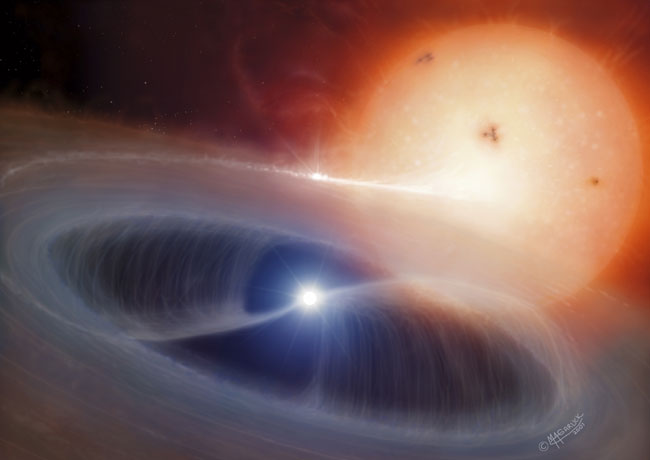The Dwarf Nova GK Per
On March 8th 2010 I tweeted that "The Dwarf Nova GK Per has gone into outburst." But what is a Dwarf Nova, and what's special about GK Per?
What is a Dwarf Nova?

Image: Andy Beardmore
An image of a Dwarf Nova, produced by my colleague Andy Beardmore, is shown on the left. It is a binary system (that is, it contains two stars). The more massive of the two (the primary is the smaller one, a White Dwarf. These typically have as much mass as the Sun, compressed into an object the size of the Earth. The other star (the secondary) has less mass than the White Dwarf but is much larger. The stars are so close together that the gravitational pull of the White Dwarf on the outer edges of the secondary is actually stronger than the pull of the secondary itself, so matter is dragged of the secondary and spirals into an accretion disc of matter which eventually drains onto the white dwarf.
The type of system just described is actually a type called a Cataclysmic Variable (or CV for short); Dwarf Novae are just one type of CV. In a Dwarf Nova matter comes into the disc from the secondary more rapidly than it leaves the disc to settle on the White Dwarf. So the disc gradually fills up. Eventually it hits a critical point where it becomes unstable. It heats up rapidly and finds a new stable state; in this state matter passes through the disc much more quickly and the disc drains. Because the disc is hotter and matter is travelling through it so quickly, it gets much brighter and we call it a Dwarf Nova outburst (the name is a misnomer. Originally these were thought to be similar to Nova eruptions but not as bright, hence the name. In fact a Dwarf Nova is nothing like a Nova at all). Eventually the disc has drained enough material that it again becomes unstable and has to cool radpily and reverts back to the earlier state, it gets fainter, the disc starts to fill up, and the cycle begins again.
What's so special about GK Per?
GK Per is not a typical Dwarf Nova, for a variety of reasons. First, most CVs and Dwarf Novae have Red Dwarf secondaries, which orbit the White Dwarf every few hours. In GK Per the secondary is a much larger (but not more massive) Red Giant, which takes almost exactly two days to complete an orbit. This means that it has a very large accretion disc and the outbursts last quite a long time — typically 70 days or so, so we can study different phases of the outburst in detail. Second (and this is why I personally like this star) it's something called an Intermediate Polar (IP) and I have a soft spot for these systems, having spent my PhD studying them.

Image: (c) Mark Garlick /space-art.co.uk
An illustration of an IP is shown to the right. It looks like a normal CV except that the middle of the disc is missing and there are these strange loopy things instead. This is because the White Dwarf has a fairly strong magnetic field. This eventually disrupts the disc and pulls the material out of it, onto the magnetic field. Instead of flowing onto the White Dwarf through the disc, the material flows along the magnetic field. When it hits the White Dwarf the material has been squeezed into a very small space and is moving very fast, so as it hits the star and is decelerated rapidly it gives off X-rays. The white dwarf is spinning round (in GK Per it revolves every 351 seconds) and the brightness of the X-rays changes as this happens because our view of the X-ray emitting areas changes. By studying this change in X-ray brightness, and how it varies between outbursts and the quiescent times (that is, when it's not in outburst) we can learn a lot about the physics of the specific system, but also about accretion discs in general. Accretion discs occur in many areas of astrophysics: around new stars, black holes, active galaxies and maybe in GRBs, so it's really important to understand them, and objects like GK Per give us an excellent insight into what goes on in these discs.